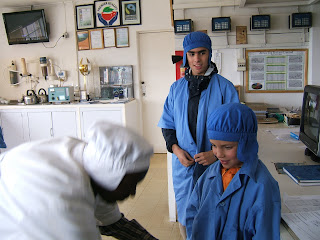February 1, 2011
Kigali
Tuesday was National Heroes Day (somewhat like our Veteran’s Day) so we all had the day off. We decided to hire a driver and take a trip north to visit the Sorwathé (Societé Rwandanise pour la production et le commercialisation du Thé) tea factory and tea plantation. The factory is located about 75Km from Kigali in a small town in the north. The Sorwathé tea is the only fair trade and grown without pesticides tea in Rwanda. Both tea and coffee are exported from Rwanda. Sorwathé produces about 3 million kilos of tea annually which is 15% of all the tea production in Rwanda.
This was my first chance to get out of Kigali to really see the countryside. The trip started on a paved and potholed highway which, we turned off of after an hour of driving onto a dirt road that wound through fields and fields of tea. When we arrived at the factory, our driver arranged (in spite of the holiday) for all of us to go on a tour and learn how they produce the tea. First we needed to garb up.
 |
| Tea Fields |
 |
| The latest in tea factory fashion |
The tea making process has 7 steps:
1. La Cuillette (plucking/harvesting) - every ten days the top three leaves of a plant are picked by hand
2. Le Transport (transport) - baskets of tea leaves are dropped into a truck and then brought up the mountainside to the factory
3. Le Fletrissage (withering) - in the factory the tea is laid out and allowed to wither and then it is sorted and a sample is weighed to determine if the tea picked is of sufficient quality to continue with the process
 |
| Box for sorting tea |
6. Le Sechage (drying) - huge fires are kept burning from local wood which they cut down and then replant
 |
| From tea leaves through the stages to tea |
 |
| The train is a mystery since Rwanda does not have a rail system |
As we drove off our driver offered to take us to Ruhengeri/Musanze to see the volcanoes. We had a lovely late lunch in Ruhengeri as we waited for the clouds to lift but the clouds never lifted so we had no view. Ruhengeri is both home to the Volcanoes National Park and the start of most gorilla trekking expeditions so I am sure I will return at some point soon. In spite of the clouds and the rain we had some amazing views of the mountains and hills of Rwanda.





Hey Julia,
ReplyDeletethanks for the link, I very much enjoyed reading your blog, I can picture it quite well now, or taste, hmmmm.. the African tea. What piece of luck that you got that house from Emily and that the children seem to do well in school. Maybe you'd start a parallel career as a travel writer, funny, too your teaching "attempts".
How long will you be in Rwanda, end of May?
Say hello to Patricia and the kids from me, please
Sylvia
Dang, stop erasing...
ReplyDeleteunmuddy stats: impossible in any language!
Learn the cultural rules before further attempts at teaching.
Sounds like continuous streams of remarkable sensory input.
Thanks for sharing along this journey!
Love to all of you
janet